This palak paneer dhaba style recipe will become your all-time favorite! It has all the nutrition, flavor, and that gorgeous color of the classic spinach and paneer recipe without the time-consuming steps.
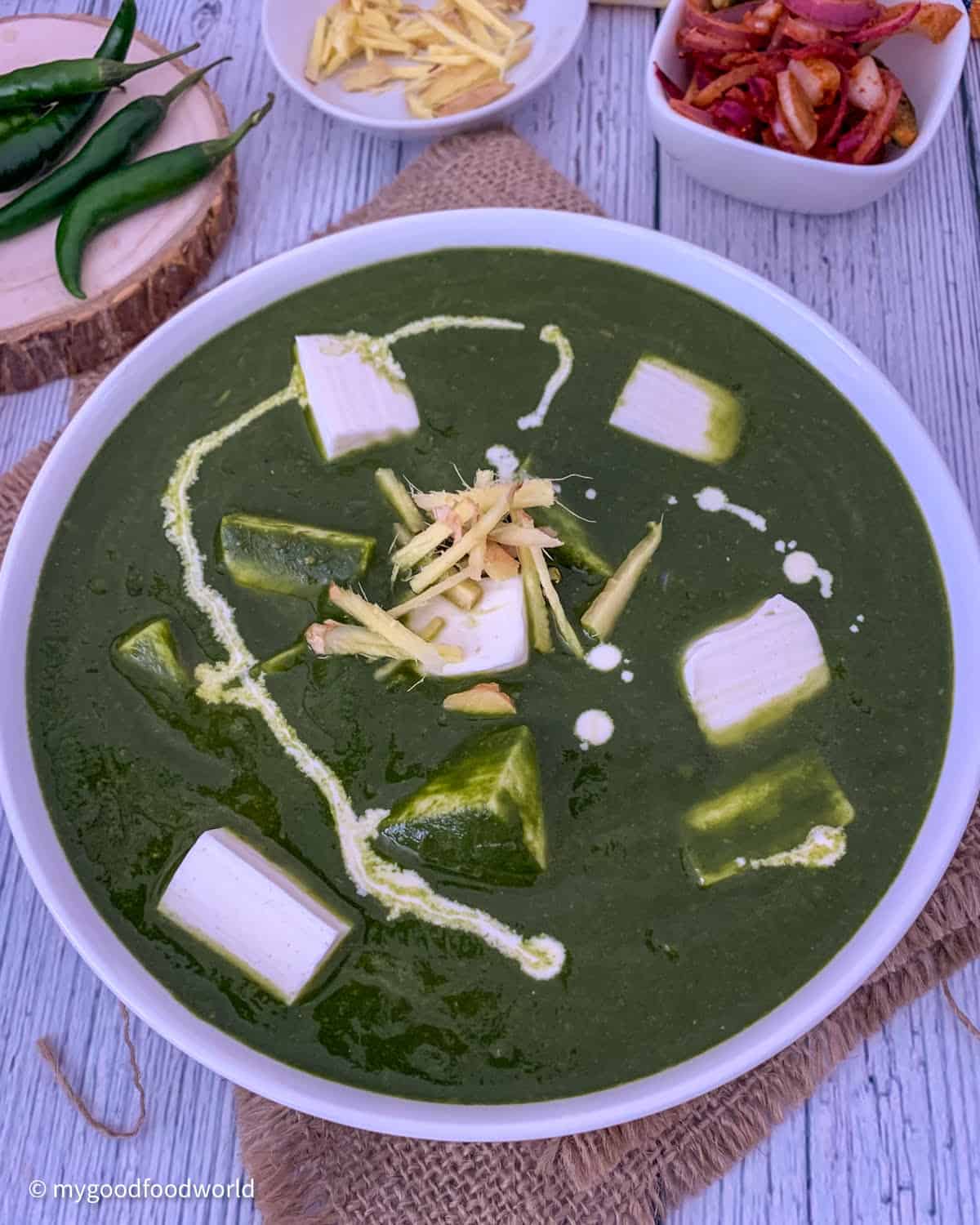
Save This Recipe
Enter your email & I'll send it to your inbox.
By submitting this form, you consent to receive emails from MyGoodFoodWorld
This post contains helpful notes and tips to help you make the perfect dish. However, if you are in a rush, please use the "Jump to Recipe" link above or the "Jump to" links below to get to the section you want.
This hearty dish, like aloo palak and bhindi masala, represents rustic, home-cooked food that people serve with warmth and love. Creamy cubes of paneer - Indian cottage cheese - delicately simmer in an aromatic, mildly-spiced, gorgeous-green spinach gravy.
The dish captures the authentic, wholesome flavors of dhaba - roadside eateries along Indian freeways (highways).
Spinach recipes are easy, tasty, and nutritious - ideal for a weeknight dinner menu!
You can pair your main dishes with aloo palak, palak raita, or a quick spinach stir fry as sides. Or you can enjoy spinach in your main dishes, like spinach dal or spinach pulao!
What is your favorite spinach recipe? Do let me know in the comments below. I would love to hear from you. - Padma
Jump to:
What is the difference between Palak Paneer and Saag Paneer?
Palak paneer vs Saag paneer: These two popular Indian dishes both feature paneer (Indian cottage cheese) as a key ingredient, but they differ in the greens they use to prepare the dish.
The main green component in palak paneer is spinach (palak), which gives the dish a vibrant green color. In this dish, the paneer is cooked in a creamy, silky spinach gravy.
Saag paneer, however, is a more general term that covers any dish where paneer is cooked in a creamy gravy with a mix of different leafy greens, including spinach.
The term “saag” refers to various greens, such as spinach, mustard greens, fenugreek leaves, and other local greens found in Punjab.
Therefore, saag paneer can have a more complex flavor and a darker green color than palak paneer.
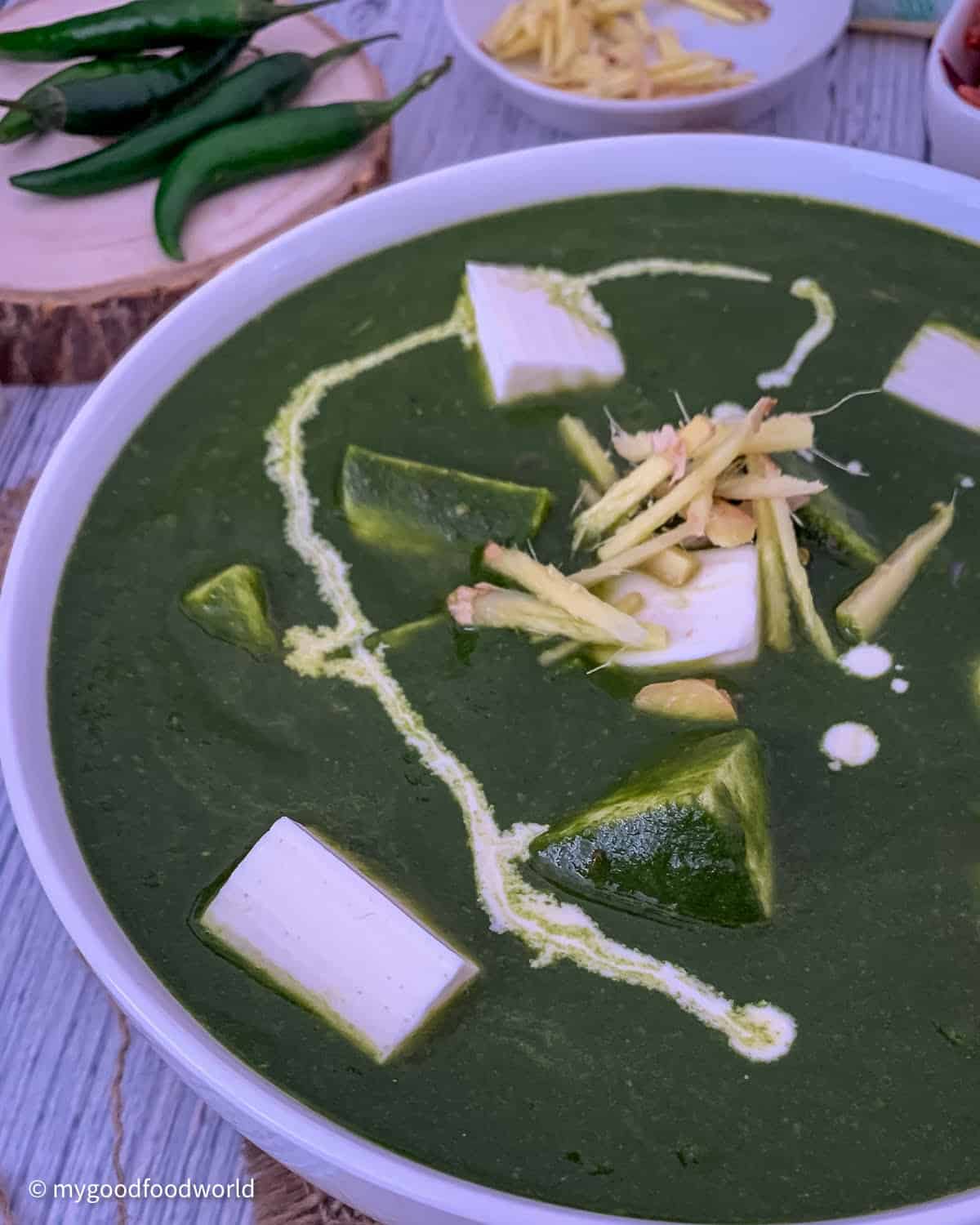
Allergen free labels
This nutritious recipe is naturally vegetarian and is:
- Gluten-free
- Grain-free
- Nut-free
- Soy-free
This recipe can be made plant-based - see notes below.
Why this palak paneer recipe?
- Quick and easy - it takes only 40 minutes to make, including prep time!
- Mess-free - it simplifies the classic recipe without compromising the authentic flavor and color.
- Time-saving and easy to clean - it reduces the number of steps and dishes.
- Flavorful and mild - it has a delicious taste that even kids can enjoy.
- Vegan-friendly - see notes below for how to make it vegan.
- Healthy and nutritious - it is packed with vitamins and minerals.
- Make-ahead - see notes below for how to store and reheat it and also what to do with any leftovers.
Ingredients
You may need to visit an Indian store for some of these ingredients, but trust me, it will pay off!
Please refer to the recipe card for quantities.
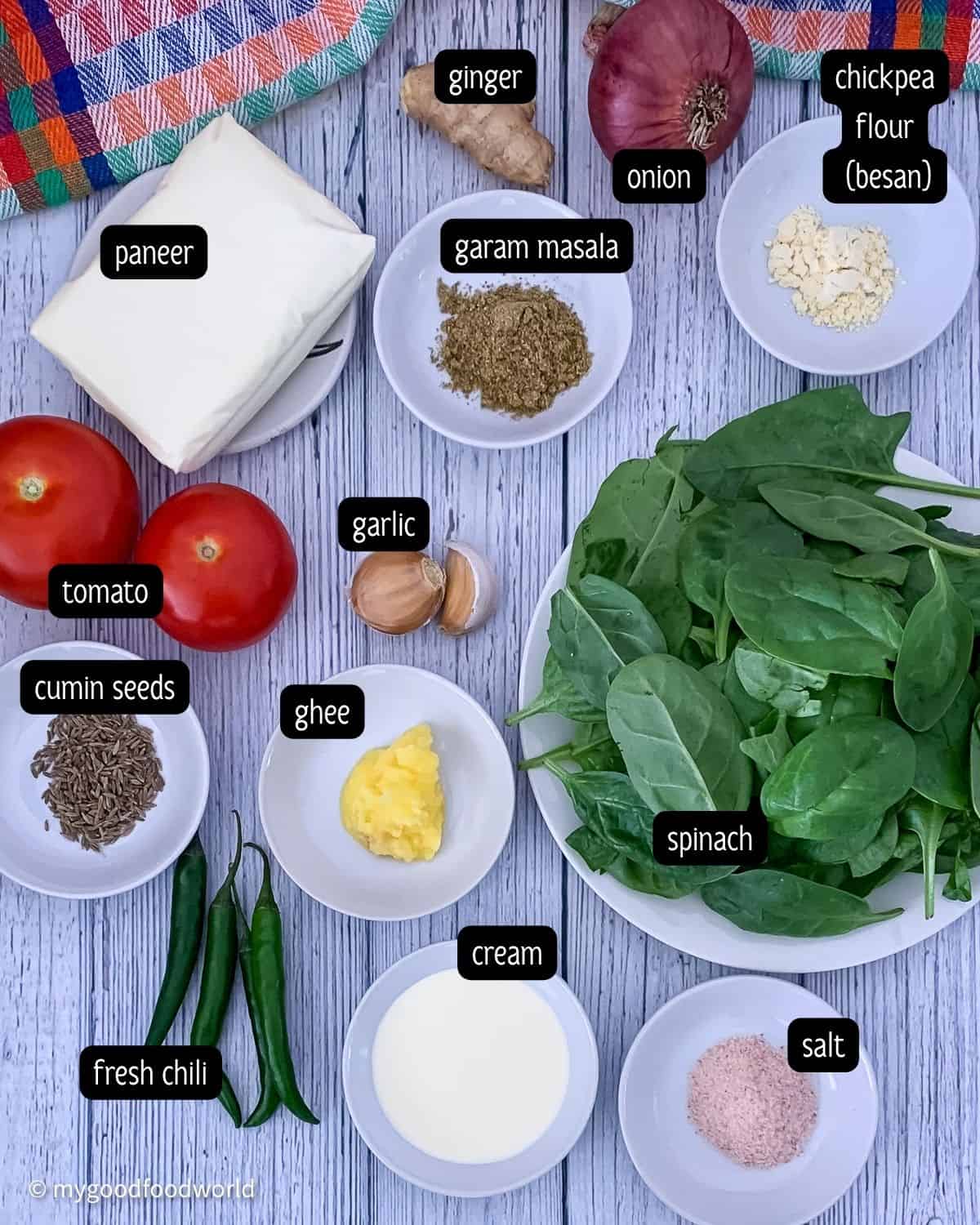
Paneer: You can choose store-bought or homemade one.
Palak (spinach): I use spinach leaves and tender stems only.
Chilies: Use green ones, not red ones. Pick the ones that suit your spice level. Remember that the chilies and the garam masala are the only spices that add heat to this recipe.
Ghee: Use ghee for the best flavor. You can also use any good-quality neutral oil if you don’t have ghee.
Cream: I add heavy (double) cream.
If you have any questions regarding these ingredients, feel free to ask in the comments section below and I will try my best to answer them for you.
Making this dhaba palak paneer
To make this recipe the classic way, you need to do a few things: first, blanch the spinach and cool it in ice water, then blend it into a puree; next, grind the onions, ginger, and garlic into a paste; and finally, puree the tomatoes separately.
Although I occasionally prepare this elaborate version, most days when time is scarce, this quick variation of the classic recipe saves the day - and it tastes and looks just as great!
Are you ready to make this easy palak paneer recipe?
Also, see the video at the end of the recipe card.
Step 1: Let’s start with some prep work:
Cut the paneer into, roughly, 1 inch cubes and soak them in warm water for 10 minutes or until the recipe call for them.
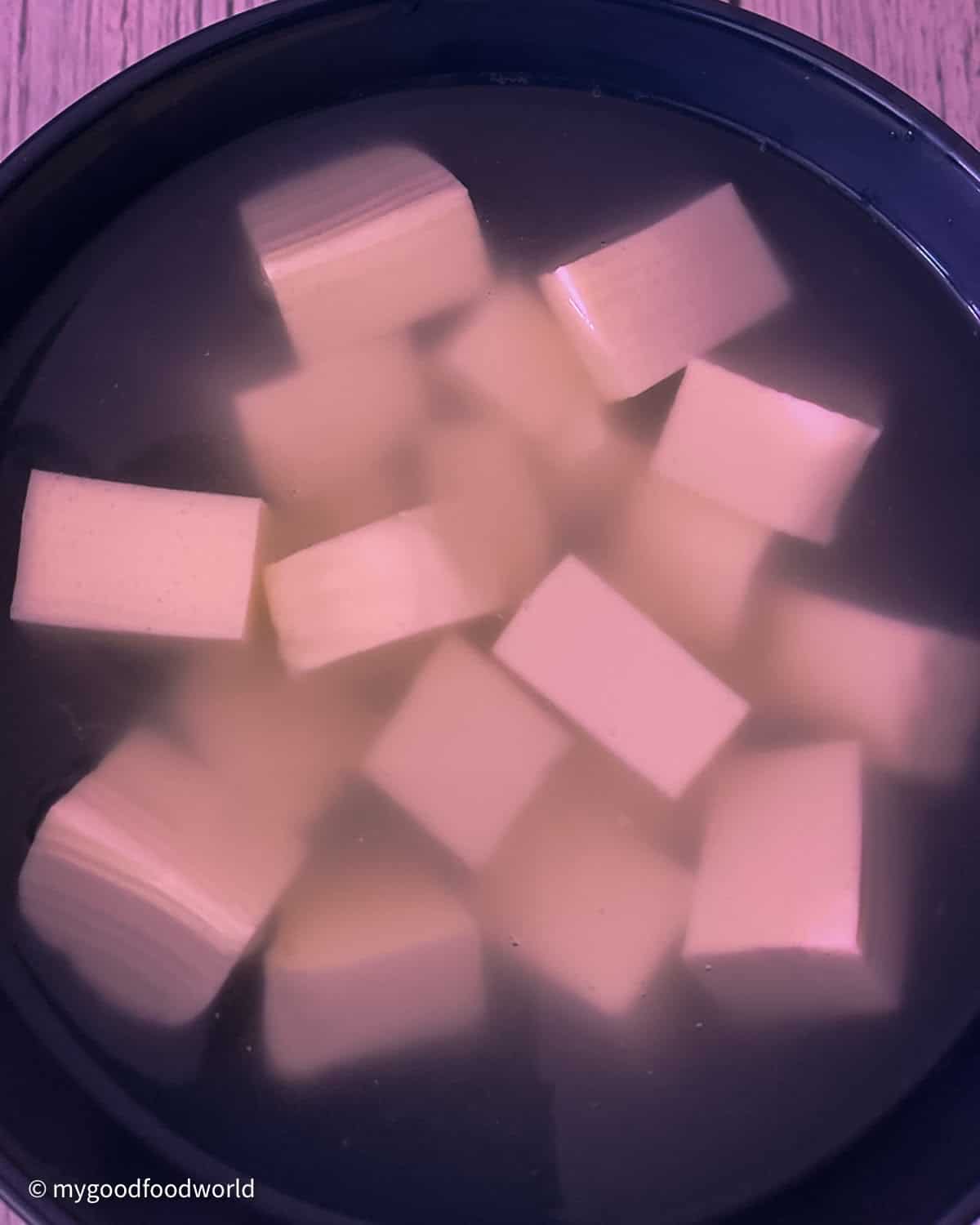
Chop, roughly, the tomato, chilies, ginger and garlic for the gravy. Set them aside. Rinse and drain the spinach.
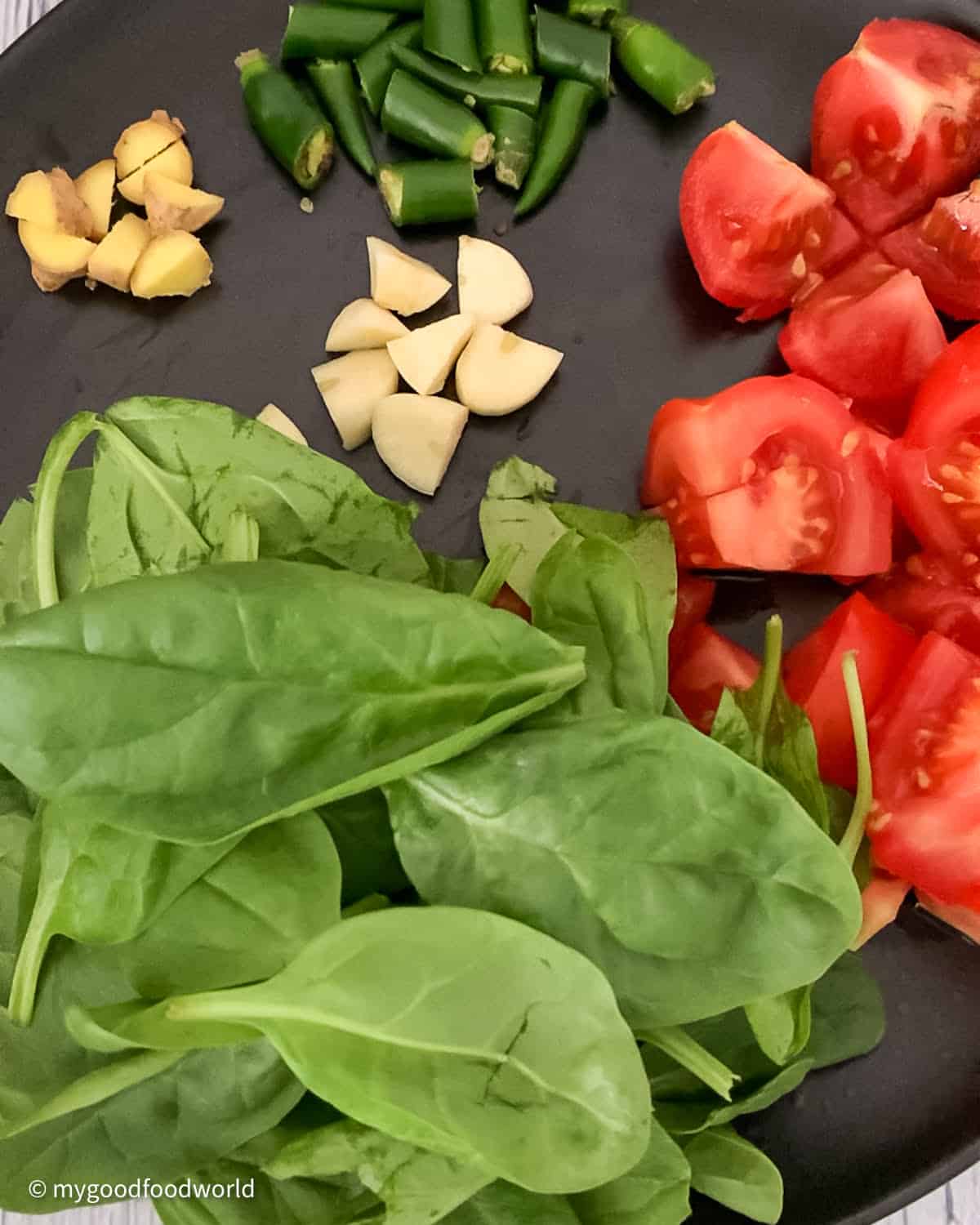
Finely chop the onion and garlic (aromatics) and set them aside.
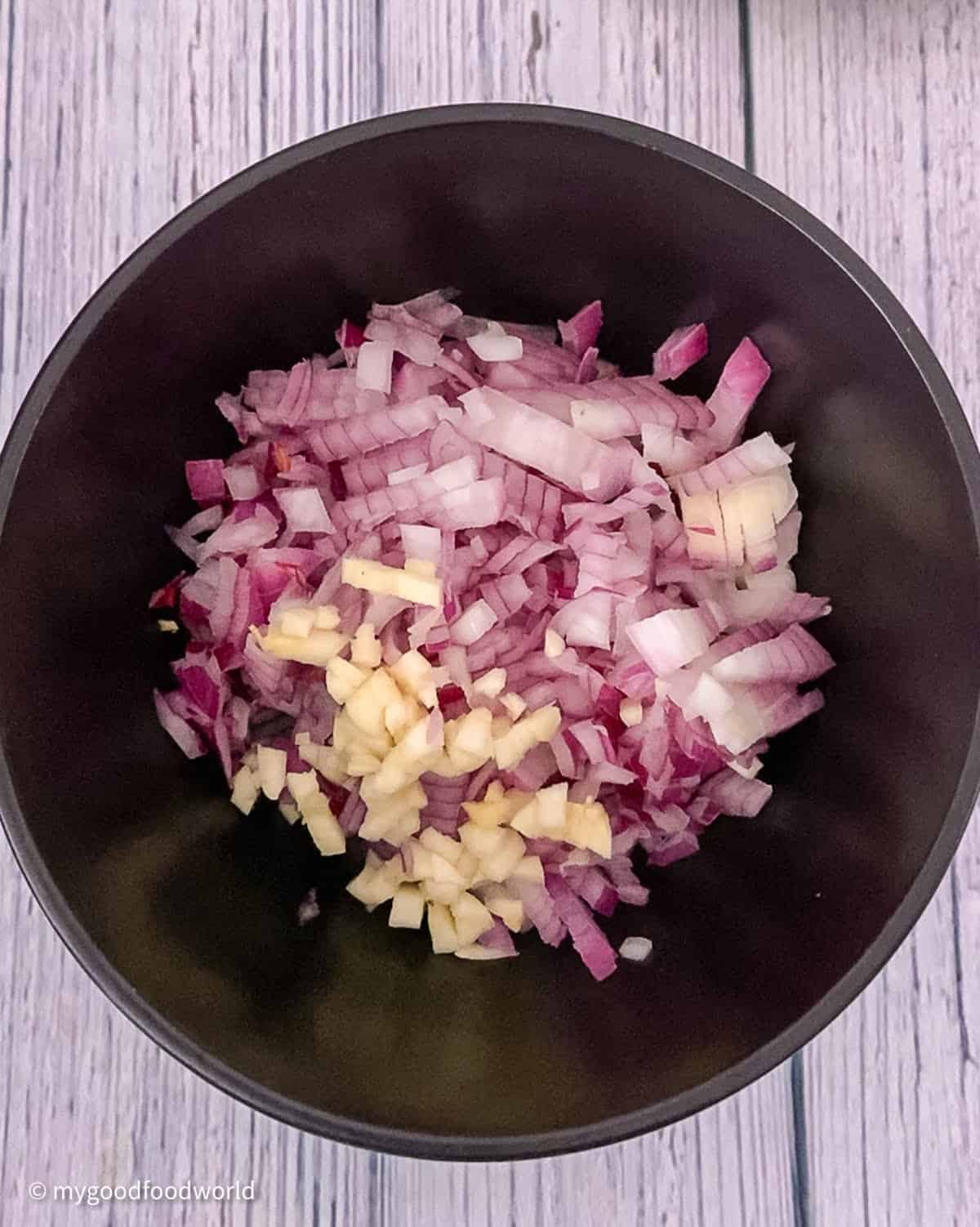
Boil ¾ cup water (to add to the gravy later).
Measure the rest of the ingredients.
Step 2: Make the spinach gravy:
Put the wok on high heat. Add the chopped tomato, garlic, ginger, and chilies to it.
Next, put the washed spinach in the wok. You may have to push down the spinach to make them fit.
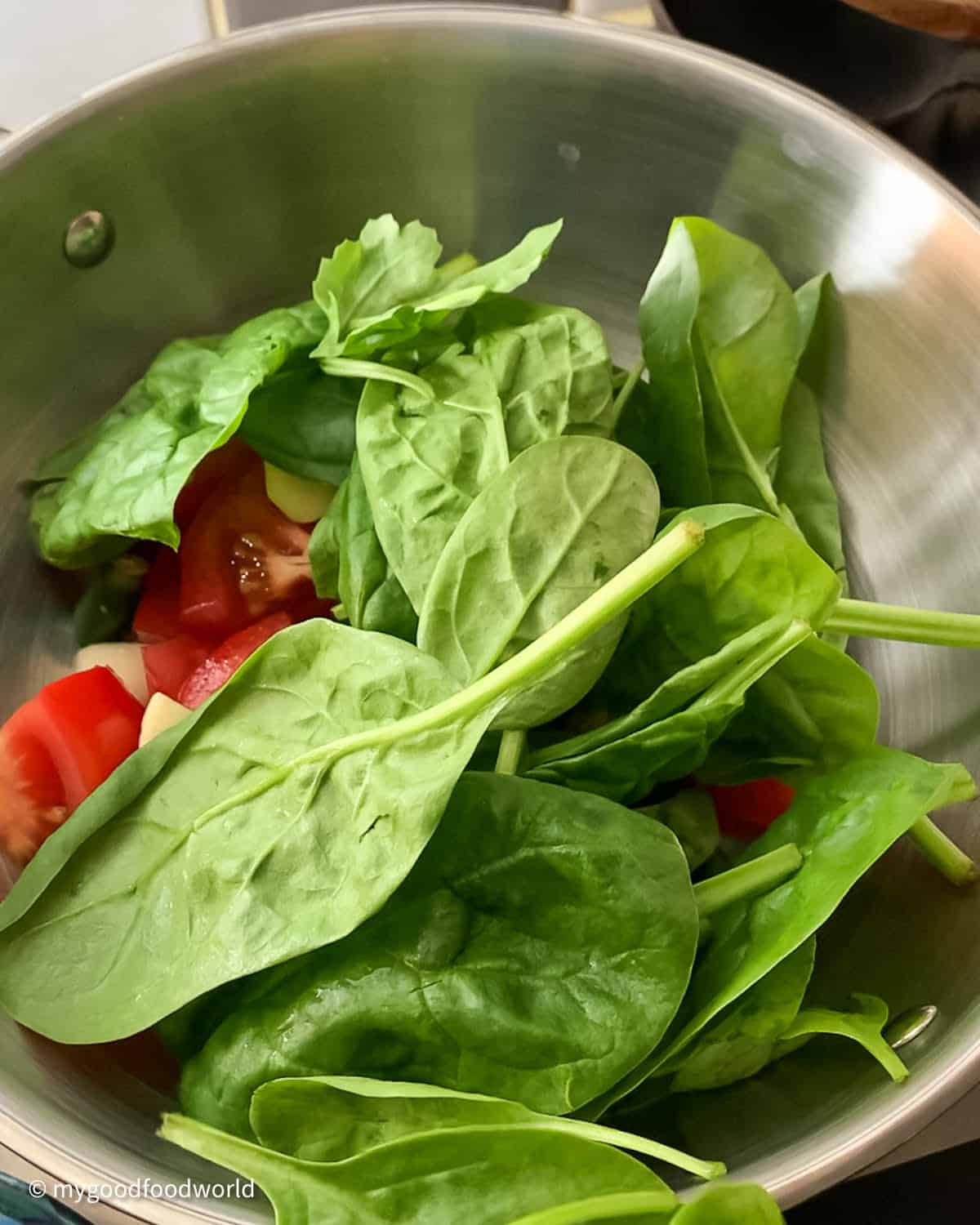
Cover the wok with the lid and let the spinach steam (on high) for 5-6 minutes or until the the leaves wilt. You don’t need to add any water because the spinach will release enough water to create steam.
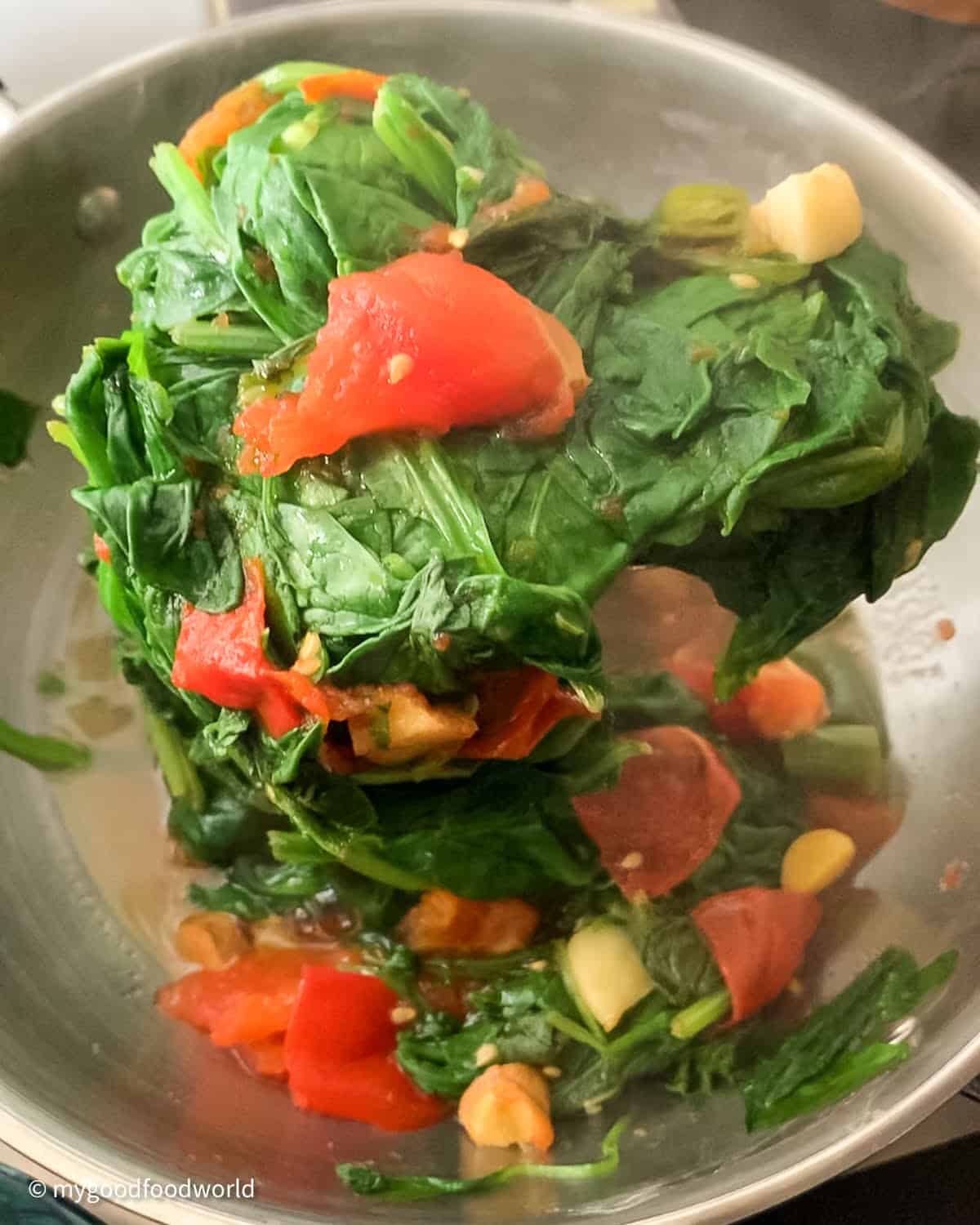
Tip the spinach mixture into a wide bowl-plate and let it cool. When cool, grind it to a smooth puree (see video below). Keep aside.
Step 3: Make palak paneer:
Heat the wok on medium heat. Then, add the ghee and cumin seeds to it. Wait for the cumin to sizzle, and then add the finely chopped onion and garlic. Fry them for 3-4 minutes or until they start turning golden.

Next, add the chickpea flour. Mix it well (no lumps) and fry for another minute.
Then, add the spinach puree and water. Boil and cook for 3-4 minutes on medium heat.
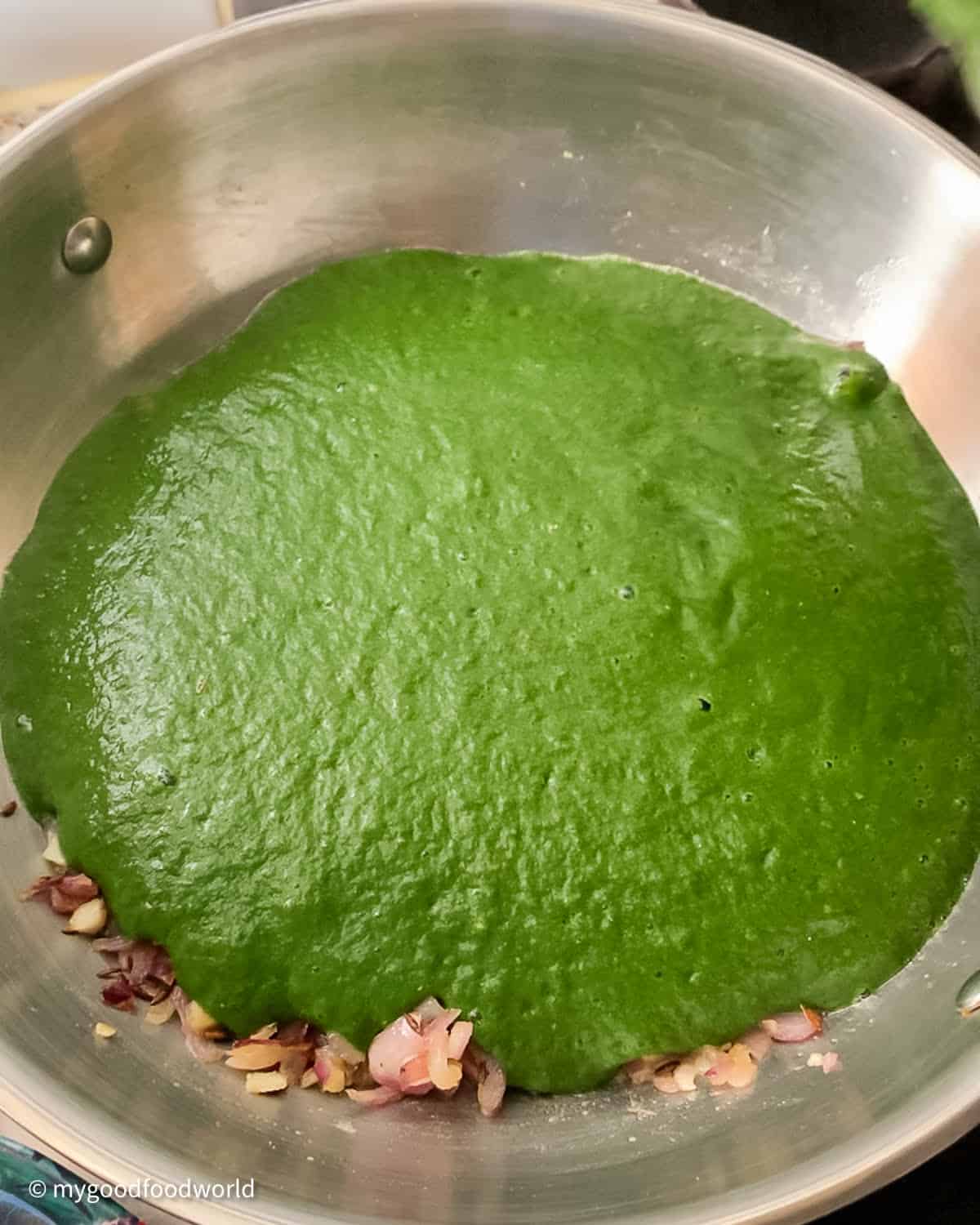
Take the paneer cubes out of the water and put them in the spinach gravy. Add the salt, garam masala, and cream. Stir well. Boil again and cook for 2-3 minutes.
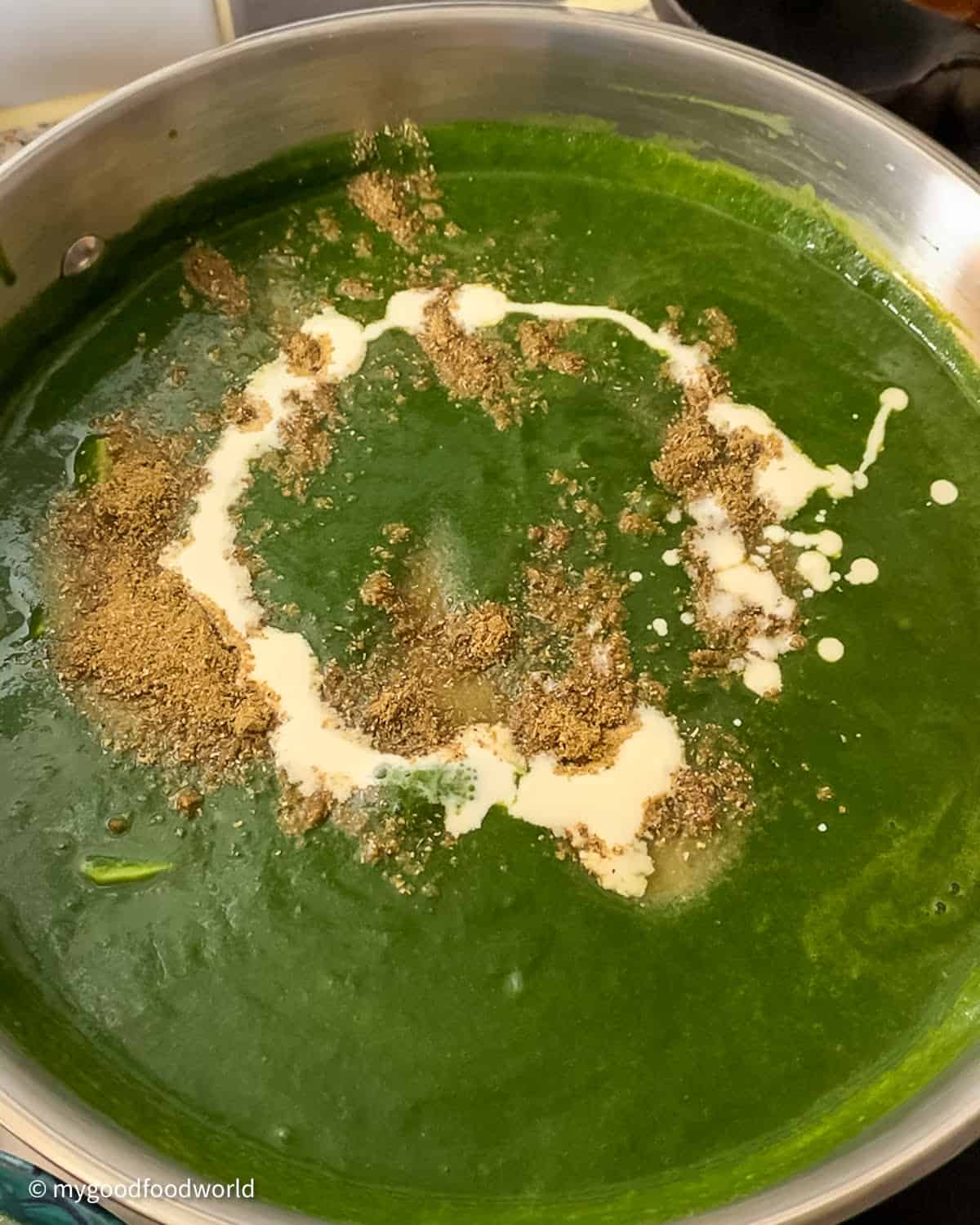
Take it off the heat and sprinkle some ginger slivers and more cream on top (this is totally optional).
You’re done! Enjoy your delicious, creamy and healthy palak paneer recipe dhaba style! See the section below for serving suggestions and meals ideas.
Pro tips and notes
To get that gorgeous green spinach gravy, follow these tips:
- Use fresh and tender spinach
- Leave the spinach whole
- Steam the spinach briefly (5-6 minutes is enough)
- Let the spinach mixture cool down for at least 10 minutes before pureeing it (put it in the fridge or under the fan/ AC, if required).
- Add salt towards the end. Adding salt early on will make the spinach lose its color.
- Cook the spinach puree for a short time - in this recipe, I cook it for only 6-7 minutes and that is enough.
What not to add: You may see that I don’t use the common curry spices such as turmeric powder, red chili powder and coriander powder.
These spices will change the color of the gravy and make it less green. Turmeric will also turn the paneer yellow. In this recipe, the paneer should stay white.
Why chick pea flour? The reason for chick pea flour is that it thickens the gravy and makes it smooth and perfect to scoop up with a piece of bread. Yum!
To make it vegan, you can do these changes:
- make palak tofu by using tofu instead of paneer
- neutral oil instead of ghee
- plant based cream of choice instead of dairy cream
Any doubts or questions? Feel free to ask via the comments below. I will try my best to answer them for you. - Padma
Serving and storage suggestions
Palak paneer tastes best with some freshly made flat bread such as naan or tandoori roti. Here are some meal ideas:
- Make a satisfying grain free meal by pairing it with grain and gluten free naan, cucumber raita, and a salad of your choice.
- Love spice? Then pair this dish up with some spicy bullet naan, onions salad, and some plain yogurt. This combination is a family favorite!
- If you, like me, like to have a gluten-free meal on some days, then pair it with some jeera rice or vegetable pulao and this soothing tomato raitha.
Storage:
Refrigerator: You can keep this curry fresh and tasty for up to 2 days by storing it in a fridge-safe container with a tight lid.
To reheat from the fridge, you can pour it into a saucepan and heat it gently until it boils. Then, you can take it off the heat and serve it. Do not boil it for too long.
Freezer: You can freeze it for up to 3 months. A good tip for freezing is to freeze only the spinach gravy and not the paneer together with it.
If you want to reheat from the freezer, you have two options. You can either thaw it overnight in the refrigerator or on the countertop and then microwave it or heat it in a saucepan (as explained above).
What to do with leftover palak paneer? These creative ideas will give your leftovers a new and exciting twist, reducing waste and providing you with additional meals to enjoy.
- Make paratha dough: Blend the paneer and the spinach gravy together and then mix it with wheat flour to form a dough. Make deliciously, soft parathas with this dough.
- Pulao: You can also use the paneer palak to make pulao. Simply combine it with some leftover plain rice, season with salt to taste, and heat it up gently.
- Palak paneer rice bowl: Warm up the palak paneer and spoon it over some steamed rice. To make it a balanced and healthy meal, you can also add some roasted vegetables or a side salad.
- Palak paneer pasta: If you want to try something different! Just cook some pasta of your choice and mix it with some palak paneer and cream.
FAQ's
To make Palak Paneer less bitter, here are a few tips you can follow:
1. Use fresh spinach leaves: Fresh and young spinach leaves tend to be less bitter compared to older leaves. Ensure the leaves are vibrant green and free from any yellowing or wilting.
2. Steam or blanch the spinach before making a puree. Do not cook the spinach puree for too long.
3. Add some cream to the spinach gravy. This will balance the taste of the spinach.
4. Do not add the garam masala until nearly the end of the cooking.
The English name for "Palak Paneer" is "Spinach Paneer" or "Paneer in Spinach Gravy." In this dish, paneer (Indian cottage cheese) is cooked in a creamy spinach-based gravy, resulting in a delicious and nutritious preparation.
The healthiness of restaurant-style Palak Paneer can vary depending on the specific ingredients and cooking methods used. Generally, Palak Paneer is considered a healthy dish.
Spinach, the main ingredient in Palak Paneer, is packed with vitamins A, C, and K, as well as iron and dietary fiber. It is low in calories and rich in antioxidants.
Paneer, a type of Indian cottage cheese, provides a good source of protein and calcium.
The overall healthiness of restaurant Palak Paneer can be influenced by factors such as the amount of oil, ghee (clarified butter), or cream used in the preparation, as well as the serving size. Restaurant versions may sometimes be richer and higher in fat due to the use of additional ingredients for flavor enhancement.
If you have made this palak paneer dhaba style, please take a moment to leave a comment and a rating below. This will make me super happy and motivate me to create more good content for you! You can also engage with me on Twitter, Facebook, and Instagram xx Padma
📖 Recipe
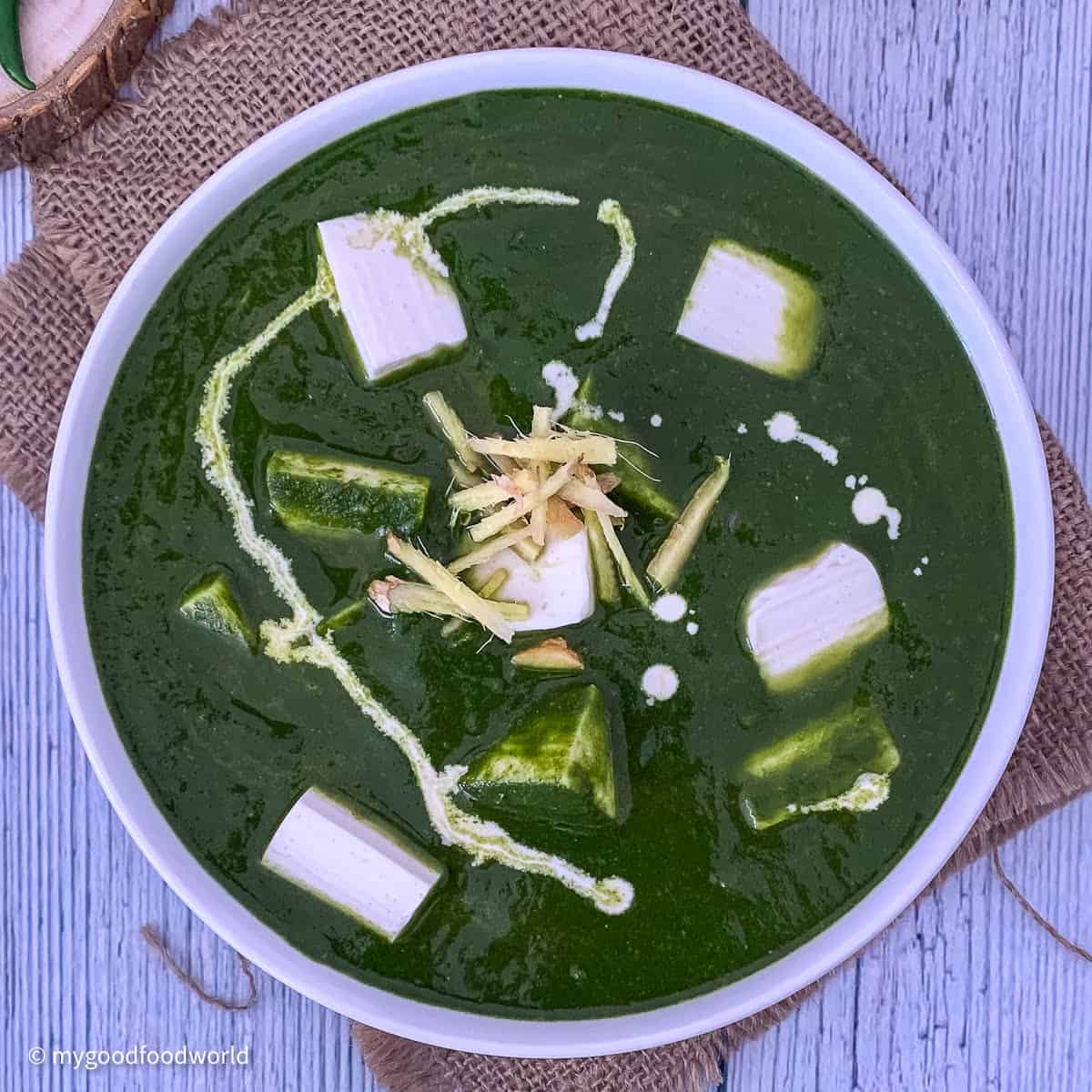
Quick and Easy Palak Paneer Dhaba Style
Save This Recipe
Enter your email & I'll send it to your inbox.
By submitting this form, you consent to receive emails from MyGoodFoodWorld
Ingredients
Equipment
Instructions
- Cut the paneer into, roughly, 1 inch cubes and soak them in warm water for 10 minutes or until you need them.
- Chop the tomato, chilies, ginger and garlic for the gravy roughly. Set them aside. Rinse and drain the spinach.
- Finely chop the onion and garlic (aromatics) and set them aside.
- Boil ¾ cup water (to add to the gravy later).
- Measure the rest of the ingredients.
- Put the wok on high heat. Add the chopped tomato, garlic, ginger, and chilies to it.1 big (~200g) tomato, 1 flat clove (~9g) garlic, 1 and ½ inches (~6g) ginger, 4 (~20g) green chilies
- Next, put the washed spinach in the wok. You may have to push down the spinach to make them fit.1 lb. (~450g) palak (spinach)
- Cover the wok with the lid and steam (on high) for 5-6 minutes or until the spinach wilts. You don’t need to add any water because the spinach will release enough water to create steam.
- Tip the spinach mixture into a wide bowl-plate and let it cool. When cool, grind it to a smooth puree (see video below). Keep aside.
- Heat the wok on medium heat. Then, add the ghee and cumin seeds to it. Wait for the cumin to sizzle, and then add the chopped onion and garlic. Fry them for 3-4 minutes or until they start turning golden.1 medium (~90g) onion, 1 fat clove (~9g) garlic, 2 teaspoons ghee, 1 teaspoon cumin seeds
- Next, add the chickpea flour. Mix it well (no lumps) and fry for another minute.1 teaspoon chickpea flour (besan)
- Then, add the spinach puree and water. Boil and cook for 3-4 minutes on medium heat.The gravy will thicken because of the chickpea flour.¾ cup hot water
- Take the paneer cubes out of the water and put them in the spinach gravy. Add the salt, garam masala, and cream as well. Stir well. Boil again and cook for 2-3 minutes.1 and ½ teaspoons garam masala, 1 and ½ teaspoons salt, 3 teaspoons heavy (double) cream, ½ lb. (~225g) paneer
- Take it off the heat and sprinkle some ginger slivers and more cream on top (this is totally optional).slivers of ginger, 1 or 2 teaspoons cream
- Serve warm with bullet naan and spiced onions salad for that authentic dhaba feel!
Nutrition
The nutritional information is calculated using an online calculator and is based on available ingredients and preparation. It should not be considered a substitute for a professional nutritionists' advice. Changing the quantities and cooking technique will alter the nutritional calculations.
Video

Notes
Alternative quantities provided in the recipe card are for 1x only.
Our content aims to be informative and educational, but it should not replace professional medical advice. Since manufacturing processes can vary and cross-contamination is possible, it's essential to verify product labels and allergen information. Make sure all ingredients align with your specific allergies. As readers, you bear the responsibility for ensuring allergen safety when buying or consuming foods.


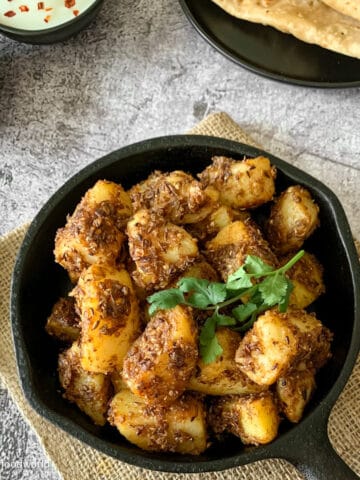
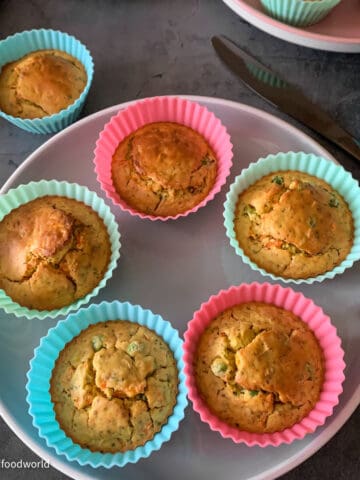
Choclette says
I'm totally in love with the colour of your palak paneer and it tastes so good too. Love these sort of simple dishes which are also complex in flavour.
Padma Kumar says
You said it Choclette!
Jacqui says
I loved making this recipe! It turned out so great, and it was really easy to follow. I used a few vegan ingredients instead of regular dairy based products like the required cream, and it was great!
Padma Kumar says
So glad you tried and liked it Jacqui. The vegan swaps are a good idea.